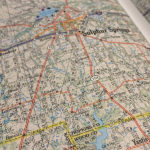This time of year, a number of Texas cities and towns have rodeos featuring competitive donkey shows, among other exhibitions and contests. Donkeys carry riders and stride around obstacles, cross bridges and jog over poles.
For a donkey to be tamed, trained and ridden, one must take the donkey through four stages: (1) calm the donkey; (2) teach it not to act on its flight instinct; (3) replace its natural fear of humans with trust; and then, (4) the donkey can be ridden, guided and spurred on as it accepts restraint.
Sometimes when a donkey without such training is ridden for the first time, it will plant its feet, buck, rear, twist, turn, and/or attempt to get the rider off its back by running them into something.
This donkey training process is interesting to me as we approach celebrating what Jesus-followers refer to as Palm Sunday. It causes me to focus on Jesus riding a previously unridden donkey-colt from Jericho to Jerusalem, apparently in fulfillment of the messianic prophecy in Zechariah 9:9, as the Gospel writers affirm.
Jesus sent two disciples to the village of Bethphage to find the tied donkey-colt for him. There is no indication it needed to be calmed or attempted flight as it submissively came to Jesus. Perhaps all four training stages had been accelerated, modified or bypassed regarding the colt prepared for and used by Jesus.
Jesus’s ride into Jerusalem
It appears that in a few moments, the unridden donkey-colt was untied, brought to, controlled, guided and ridden by Jesus. He did not ride it as if he was in a rodeo; he rode it regally and peacefully.
There’s no record the donkey-colt planted its feet, bucked, reared, twisted, turned or attempted to get Jesus off its back by running him into something.
Jesus, who usually walked, was now riding a donkey-colt into Jerusalem on his mission of peace and with a message of salvation.
Steadily riding toward and into Jerusalem—God’s great holy city, the capital and city of his faith—Jesus encountered a crowded and chaotic scene of expectant, joyful and receptive Passover festival pilgrims who had heard of his arrival. Matthew said his arrival disturbed the whole city.
Sign up for our weekly edition and get all our headlines in your inbox on Thursdays
The Gospel writers tell us that along the way, the crowd went out to meet him, waving and laying palm leaves on the road as for a king. Some went ahead of him; others followed.
The crowd enthusiastically shouted: “Hosanna (save now)! Blessed is the king who comes in the name of the Lord! Blessed is the coming kingdom of our father David! Hosanna in the highest! Peace in heaven and glory in the highest!”
The jubilant and expectant crowd experienced the moment with Jesus and vocally expressed themselves in the moment. But did they and Jesus’ followers understand the moment and its significance? John tells us even his disciples “did not understand all this.”
Some expected Jesus to be their king, national leader and political deliverer who would drive out and conquer the Romans with vengeance. Perhaps they were surprised he was not arriving in an extravagant kingly procession, riding a war horse as kings rode during times of war. Instead, Jesus rode a donkey—which kings rode during times of peace. Riding a donkey symbolized service, suffering, gentleness and humility.
The ride’s significance for us today
Jesus’ ride on an untied and tamed donkey-colt into Jerusalem on the first Palm Sunday is as relevant today as it was then because of what it represents and symbolizes. He came propelled by his Father-God’s love, humbly offering the world spiritual peace, liberation, deliverance and victory. Today, he does the same. But what difference does it make to you, and do you understand all this?
This year, how will you celebrate Jesus’ entry into Jerusalem on Palm Sunday?
What in your life needs to be untied, humbled, tamed and brought to Jesus for his use? Where do you need to trust him?
What do you expect? Are you expecting Jesus to “ride into” your life, home, marriage, health, relationships, community or throughout our country and world with an intervention of peace?
What will you experience? Are you and will you be joyful Jesus rode a donkey-colt into Jerusalem? How will you experience it? Will you do it with the in-person crowd in a sanctuary or the online crowd elsewhere? Will you experience it in your life like some in the crowd did that day long ago?
What will you say? How will you express yourself? Will you enthusiastically and loudly shout, “Praise the Lord?” Will you chant or recite, “Hosanna,” “Hallelujah” and other words from Psalm 118:25-26, as did some in Jesus’ crowd, perhaps by rote and from memory, not understanding the messianic significance?
Beyond Palm Sunday, when you are alone and not in corporate worship, will you still join the cloud of witnesses and express yourself as joyfully as if you were in the crowd, congregation or your sanctuary?
We were not there on that first Palm Sunday, but we are here now. We are able, for the rest of our days and beyond Palm Sunday, to shout, “Hallelujah,” to shout our praise.
We are able to follow and celebrate the one who came and rode a colt into Jerusalem on his way to the cross to show us he loves the world enough to be our “ride and die” friend. It was not a rodeo; it was Jesus’ ride into Jerusalem to offer salvation to all.
Rev. Joseph C. Parker Jr., Esq., who considers himself a pursuer of justice, is an attorney and senior pastor of the David Chapel Missionary Baptist Church in Austin. He has served David Chapel as a minister since 1982 and as senior pastor since 1992. The views expressed are those solely of the author.














We seek to connect God’s story and God’s people around the world. To learn more about God’s story, click here.
Send comments and feedback to Eric Black, our editor. For comments to be published, please specify “letter to the editor.” Maximum length for publication is 300 words.